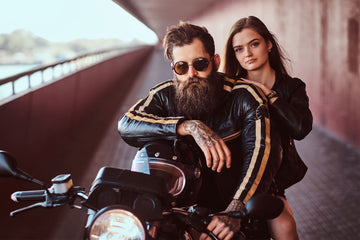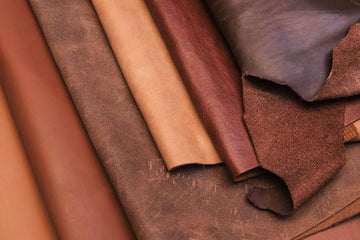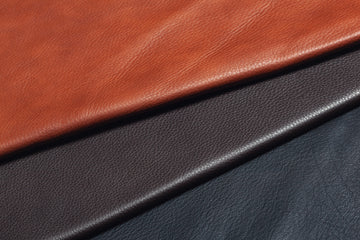The type of leather you should choose for a motorcycle jacket depends on safety, comfort, and style. A leather motorbike jacket is not just for riding but also a practical choice for casual wear. It comes in a variety of styles and materials.
Cowhide leather is the best overall choice and is highly durable in abrasion. Kangaroo leather, known for its excellent strength-to-weight ratio, durability, lightweight nature, and breathability, is also a great option. Full-grain leather offers the highest level of protection with a unique patina, while top-grain leather offers a smooth style and excellent flexibility.
Genuine leather is cost-effective but requires more durability. Split and bonded leather are very cheap but provide little protection. Lambskin is comfortable and luxurious but lacks abrasion and water resistance, while buffalo leather is highly durable with a tough texture. The leather thickness should be between 1.2 and 1.4 mm for maximum protection.
Which Leather is the Best for Motorcycle Jackets?
Leather motorcycle jackets are considered the superior choice when selecting the best material for motorcycle jackets due to their quality, durability, and protective features. Cowhide leather, in particular, is highly valued for its exceptional properties, making it the first choice for bikers' protection on the road.
It is thick and stiff, forming a solid barrier between the critical areas of the rider's body and the road's rough surfaces, preventing injuries and abrasions. Its strong fibrous structure allows vital areas of the jacket to bear harsh road conditions, providing constant protection for optimal safety and peace of mind.
What is the Best Leather for Motorcycle Leather Jackets?
The best leather for motorcycle jackets depends on everyone's preference, but a full-grain leather motorbike jacket is one of the most sought-after types. Motorcycle riding has a unique appeal and requires careful consideration of safety, comfort, and the features of different types of leather jackets.
Full-grain leather is solid, hard-wearing, and matures naturally, forming a unique patina. Proper care and maintenance of leather motorbike jackets, including waterproofing and ventilation, are essential to ensure longevity and optimal performance.
It provides a high level of protection and has a timeless look most riders prefer in motorcycle gear. Top-grain leather and buffalo leather are also popular leather types for motorcycle jackets. Top-grain leather is selected for its refined style, and buffalo leather is chosen for its toughness.
Different types of leather are used in motorcycle jackets, each with distinctive features. The common types are:
- Full-grain leather
- Top-grain leather
- Genuine leather
- Split leather
- Bonded leather.
Full-grain leather for Motorcycle Jackets
Features: Full-grain leather is the uppermost layer of the hide and has all the natural grain. It is not sanded or buffed to remove imperfections and maintains the strength and durability of the hide. Natural marks and grain patterns provide a unique look to each piece. Full-grain leather is exceptionally durable and develops a unique patina, which enhances the leather's overall look.
Pros: The most notable advantage of full-grain leather is its durability and protective features. It can withstand harsh road conditions and provides excellent protection against abrasions and impacts, making it one of the best choices for a rider who takes bike safety seriously.
Cons: Full-grain leather is expensive and one of the most costly. It is heavy and stiff compared to others and takes time to break in. Quality full-grain leather jackets or suits offer a comfortable fit, but it takes some time to adjust to your body.
Best Uses: Full-grain leather suits are best for serious bikers who ride often and need their gear for maximum protection. It is also suitable for bikers who value natural leather and can afford premium gear that will last longer and age gracefully.
Top-Grain Leather for Motorcycle Jackets
Features: Top-grain leather is produced by sanding off the natural grain from the hide's surface to remove imperfections. It is then treated and polished to make it more aesthetically appealing. This smoothened surface has less grip and, hence, provides good flexibility. Top-grain leather looks better and has fewer natural marks compared to full-grain leather.
Pros: Top-grain leather is high quality but cheaper than full-grain leather. It is more flexible and less stiff than full-grain leather and more accessible to break. Because of the treatment given during the finishing process, top-grain leather is water-resistant and stain-resistant, making it easy to maintain. Its smooth surface is preferred for the soft style, giving some riders a more refined look. Many top-grain leather jackets also have a removable thermal liner for added protection and comfort in varying weather conditions.
Cons: Top-grain leather is less durable and more rigid than full-grain leather. The sanding and polishing process makes it slightly weaker than full-grain leather, and it loses its natural breathability. Top-grain leather forms a patina with time, which means it will retain its original look and not age beautifully.
Best Uses: Top-grain leather is best for riders who look for quality and cost-effectiveness. It is suitable for riders who want a more elegant, classic look but do not need the extra durability of full-grain leather. Top-grain leather is also practical for riders who prefer a flexible, lighter jacket or suit.
Genuine Leather for Motorcycle Jackets
Features: Genuine leather is produced from the layers of the hide remaining after the top grain is split off. It is usually treated and embossed to make it look like better-quality leather. Despite the name "genuine leather," it is lower quality than full-grain and top-grain leather.
Pros: The most noticeable advantage of genuine leather is its cost. It provides the feel of genuine leather at a much lower price, making it available for every rider. It can offer good durability and protection, although less than higher grades of leather. Its treated surface makes it easy to clean and maintain.
Cons: Genuine leather is less durable and rugged than full-grain or top-grain leather. It may not provide the required protection in case of an accident and wears off sooner. The treated surface sometimes gives it a cheaper look and feel. With time, it forms a different attractive patina.
Best Uses: Genuine leather is best for serious motorcycle safety, motorcycle enthusiasts, and riders on a budget who need cost-effective yet protective gear. It is practical for some riders who ride occasionally and do not need maximum protection.
Split Leather for Motorcycle Jackets
Features: Split leather is a material formed from the lower layers of the hide, remaining after the upper layer is removed to make top-grain leather. It is usually less natural and requires a more natural grain of a higher quality leather. Split leather is mainly treated and finished to enhance its look and performance.
Pros: Split leather is cheaper than full-grain and top-grain leather and is a good option for bikers on a budget. It can be treated to look like top-grain and full-grain leather, providing a similar look at a lower price. Split leather is also often used for decorative parts of motorcycle jackets and suits, enhancing their overall look without increasing prices.
Cons: Split leather is less durable and robust than full-grain and top-grain leather. It is more prone to wear and tear and does not provide the required protection. The treated surface sometimes fails to provide breathability and can cause discomfort to the rider in hot or cold weather. Split leather cracks and deteriorates with time faster than higher grades of leather.
Best Uses: Split leather armour and budget-friendly motorbike jackets are best for decorative armour purposes. It can be used for secondary armour or stylish motorcycle jackets and suits which do not require full armour for maximum protection.
Bonded Leather for Motorcycle Jackets
Features: Bonded leather is produced from leftover leather scraps, which are shredded and glued together using polyurethane or latex. Low-grade leather contains only 5% to 10% of leather fibres. Bonded leather is usually coated with a polyurethane layer to provide a more consistent look.
Pros: The most noticeable advantage of bonded leather is its price. It is the cheapest form of leather available in the market. Bonded leather can be made in different colours and shades, providing various style options. It can be manufactured to look like genuine leather at a much lower price.
Cons: Bonded leather needs to be more durable and provide the most minor level of protection. It peels, cracks, and wears off over time, mainly when used heavily. The synthetic part of bonded leather makes it less breathable and causes discomfort to the rider in hot or cold weather. Its look and feel are also less superior compared to higher grades of leather.
Best Uses: Bonded leather is best for stylish rather than functional motorcycle jackets. It can be used for riders who focus more on style and do not need maximum protection. Bonded leather jackets and suits are suitable for casual riding or as an addition to your wardrobe.
Cowhide for a Motorcycle Leather Jacket
Leather motorbike jackets are a trend among most bikers due to their protective features and various styles. Cowhide leather possesses some exceptional properties. It is challenging, solid, and highly abrasion-resistant, providing the much-needed protection a rider seeks. This rugged leather is used extensively in motorcycle jackets for men and women.
A motorcycle jacket with good cowhide leather offers dependable protection to the rider, ensuring much-needed safety for all types of riding. It also gives female bikers a stylish and trendy look. Cowhide leather jackets for motorcycles are available in many styles and designs.
Cowhide leather has been used historically for motorcycle jackets and other riding gear because of its inherent thickness and durability. It offers protection from possible injuries and road rash, even in the most harsh road conditions. Besides its protective properties, cowhide leather has a classic and timeless style appeal.
Lambskin for a Motorcycle Leather Jacket
Lambskin leather motorcycle jackets are highly sought after because of their exceptional properties. This luxurious leather is known for its unrivalled softness, lightness, and extraordinary comfort. Many bikers prefer lambskin leather for motorcycle rides because it gives riders an ultra-smooth and supple feel and adds a luxurious charm to the rider's style.
A lambskin leather motorcycle jacket is made from the hide of a young sheep or lambs. The finer texture of lambskin leather than the other two leather motorcycle jackets of types gives it a smooth and sophisticated look. Its natural fluidity provides a contoured close fit and enhances the rider's style with a sleek and streamlined look. Lambskin leather motorcycle jackets may need more thickness and abrasion resistance than heavy leather like cowhide or buffalo leather.
Buffalo Leather for a Motorcycle Leather Jacket
Buffalo leather motorcycle jackets are preferred by riders who desire rugged style and maximum durability. Handcrafted from buffalo hide, this full leather motorcycle jacket offers unrivalled abrasion resistance, providing superior protection to the bike and the rider. Its waterproof and strong fibrous structure can withstand harsh road conditions, offering maximum defence against possible injuries and road rash.
The most attractive feature of buffalo leather is its unique natural grain pattern, which gives the jacket personality. The variations in the natural grain of buffalo leather add a sense of adventure and genuineness, making the beautiful appearance of the material and each coat unique.
Which Leather Type Is Best for Motorcycle Leather Jackets?
Durability
Full-grain and top-grain leather have the highest durability. Full-grain leather, being the highest quality, is extremely tough and durable. It can bear harsh road conditions and provides excellent protection against abrasions and impacts, making it a perfect choice for riders focusing more on safety and durability. Though less durable than full-grain leather, top-grain leather offers excellent strength and is less prone to wear and tear.
Genuine leather made from the remaining layers of the hide offers moderate durability. It can endure daily usage but may not take the same level of abuse as full-grain or top-grain leather. Split leather, made from the fibrous part of the hide, and bonded leather, made from shredded leather scraps, are the least durable. It is more prone to wear and tear with time, especially in harsh road conditions.
Comfort
Another major factor to consider while choosing leather for motorcycle jackets and suits is comfort. Top-grain leather is regarded as the most comfortable because of its flexibility and relatively lighter weight. It conforms better to the body and offers a relaxed fit from day one. Full-grain leather is initially stiff and takes time to break in. Regular use softens up and takes the shape of the wearer's body, providing a custom fit and becoming more comfortable.
Genuine leather offers good comfort but may have different flexibility than top-grain leather. Split-back and bonded leather are often less comfortable due to their lower quality and treatments applied to make them leather, making them less breathable and stiffer.
Aesthetic Appeal
The aesthetic appeal of leather is also a significant consideration for many riders. Full-grain leather is prized for its natural beauty and unique patina, which develop over time. This patina provides a character and uniqueness to the jacket or suit, making it more attractive as it ages. Top-grain leather has a smooth and consistent look, giving a sleek and refined style, which many bikers prefer.
Genuine leather, although still attractive, does not possess the same patina as full-grain leather. It can look good when worn from day one but may need to age better. Split and bonded leather, though often treated to look better, lacks depth and richness compared to higher-quality leather. They can look attractive from a distance but tend to deteriorate with time.
Considerations to Select Leather for Motorcycle Jackets
Riding Style
The nature of your riding also determines the selection of the best leather for your motorcycle jacket. If you are a long-distance tourer, you need a jacket that can provide maximum durability and comfort. Full-grain leather is the best option for long-distance riding because of its toughness, ability to stretch with time, and custom fit. It can bear wear and tear with prolonged usage and keep your motorbike jacket in excellent condition for years.
However, the jacket requirement is less demanding if you are a casual rider or a short-distance tourer. For such riders, top-grain or genuine leathers would be more suitable. These leather types ideally compromise comfort and durability without the extra price tag of full-grain leather.
Climate and Weather Conditions
The climate and weather conditions where you ride also determine the type of leather jacket you should choose. Leather reacts differently to rain, snow, wind and temperature changes and selecting the appropriate type can improve your comfort and protect the jacket from deterioration.
Genuine leather, while less resistant than full-grain and top-grain, can still provide adequate protection with proper care and treatment. For climates with extreme heat, consider leather jackets with ventilation options or perforations to enhance breathability.
How Thick Should Leather Be for a Motorcycle Jacket?
To ensure top-notch protection and longevity, it is recommended that the leather utilised in leather motorcycle jackets be 1.2 to 1.4 millimetres thick. This specific thickness range strikes an ideal balance of safety, safeguarding against abrasions and impacts while retaining the rider and jacket's flexibility and comfort.
Leather within this particular thickness range is sturdy enough to be a reliable shield and the best protection against road rash and other potential injuries resulting from a fall or accident. Simultaneously, it remains pliable, lightweight, and sufficient for comfortable movement and easy wear, crucial for extended rides and maintaining control over the motorcycle.
Summary
When selecting the best leather for motorcycle jackets and suits, it is crucial to understand the various types of leather available, such as full-grain, top-grain, genuine, split, and bonded leather. Factors such as durability, comfort, aesthetic appeal, and cost should be considered to make an informed choice. We recommend full-grain or top-grain leather for its exceptional longevity, superior protection, and attractive ageing qualities.
Purchasing high-quality leather hides from reputable online merchants ensures that your motorcycle gear will last for many years with proper care. Good maintenance practices, such as conditioning and waterproofing, will further enhance the durability and appearance of your leather jacket or suit.
🔗 Buy leather for motorcycle jackets
Don't hesitate to contact us if you have any questions about the different types and grades of leather used for making motorcycle gear. We are here to help you better understand each type of leather and help you choose the right one to enhance the aesthetics, overall durability, and longevity of your leather motorcycle jackets and suits.






